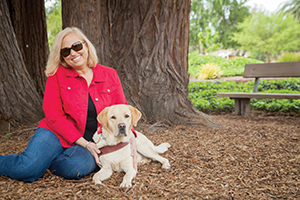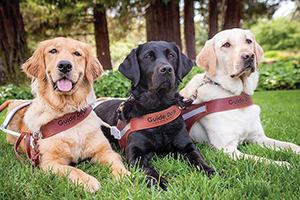By BETSY TAYLOR
Emma is a border collie mix with a specialized skill set — she can smell when 47-year-old Kathleen Simmonds, a diabetic, has blood sugar levels that are too high or too low, and she'll prod at Simmonds repeatedly with her snout, to prompt the woman to take steps like increasing her insulin dose or having a sweet drink to get her levels back to a healthy range.

The affection between Kathleen Simmonds and her support dog Emma is mutual.
Karen Elshout/© CHA
Emma lives with Simmonds' family in the St. Louis suburb of St. Charles, Mo. The service dog, trained by an Indianapolis for-profit called Medical Mutts, also can retrieve a soda for Simmonds, if she needs the sugar to boost her levels, and bark and go for help inside the home, if Simmonds were to have a medical episode where she cannot summon help herself.
Emma's constant vigilance as a diabetic alert dog helps Simmonds manage her Type 1 diabetes. The dog, she has found, is more sensitive to her changing blood sugars than the electronic monitoring and alert equipment Simmonds wears. Researchers haven't determined specifically what the dogs smell. Medical Mutts has taken part in a published study documenting the effectiveness of diabetic alert dogs in detecting low blood sugar.
Simmonds brings Emma with her almost everywhere. Due to diabetes' effects, like nerve damage, Simmonds said she can't feel her body's natural signs when her blood sugar is high or low. Before Emma's arrival, her family worried about leaving her alone, afraid she might fall unconscious due to an insulin imbalance. Emma's presence gives them all confidence.
Said Simmonds: "She has given me a better quality of life. I can live life without being afraid. She has given me a sense of normalcy. There's a huge psychological benefit. I feel like we're a team."
Working dogs
The Americans with Disabilities Act defines service animals as dogs individually trained to do work or perform tasks for people with disabilities — such as guiding people who are blind, providing an alert to someone who is deaf, pulling a wheelchair and protecting someone having a seizure.

Kathleen Simmonds' diabetic alert dog Emma is attentive and focused on her in the Simmonds' St. Charles, Mo., home. The dog senses when her blood sugar is too low or too high and prods her vigorously to check her blood sugar monitor. Karen Elshout/© CHA
Simmonds carries wallet-sized cards with her that outline the basics of federal law related to service dogs. She hands them out as a courtesy to educate people if they have questions.
The card explains it is against the law to discriminate against someone with a service dog. Government, businesses and nonprofit organizations that serve the public, including health care organizations, generally must allow service animals to accompany people with disabilities in all areas of a facility where the public is normally allowed to go.
If an employee can't tell if an animal is a service animal, the staffer can ask two limited questions under the law: Is the dog a service animal required because of a disability? What work or task has the dog been trained to perform? The employee cannot ask specifically about the person's disability, or require medical documentation of a disability or documentation for the dog. The dog must be under the handler's control in the public place.
The dog may wear a special vest indicating it's a service dog, but it is not required. As a matter of etiquette, people should not pet a service dog while it is working and out in public. They should also address the handler, and not the dog, when greeting the team, say those who have service dogs.
Organizations that train service dogs follow a lengthy, thorough and costly process to prepare the animals for duty. Medical Mutts said it operates as a for-profit business because it wants to focus on training dogs, not fundraising. Simmonds said Emma and her specialized training cost $14,000. Some people do fundraise in their own communities to help pay for a dog, said Medical Mutts co-owner Jennifer Cattet.
Hero Dogs
Hero Dogs, a Brookeville, Md.-based nonprofit that provides service dogs to veterans free of charge, has a staff of six and about 100 volunteers. Volunteer puppy raisers, matched with puppies who live in their homes, socialize and train puppies in basic skills under the guidance of Hero Dogs staff until the dogs are about a year and a half old. From there, professional trainers at the Hero Dogs facility teach each dog specialized skills and tasks.
Each dog is trained to help a disabled veteran achieve greater independence and to reduce that person's reliance on other people for assistance. Dogs can provide balance support and help a person sit, stand or walk. They can alert a human partner with hearing impairment to the sound of a doorbell, an alarm or the person's name being called.
Some of them can retrieve items, open and close doors, operate light switches and automatic door openers. A dog can be trained to wake its partner from nightmares, which can be important if a person with a condition like post-traumatic stress disorder is debilitated by nightmares.
Pam Budke, executive director of the nonprofit CHAMP Assistance Dogs in Florissant, Mo., said service dogs can also be trained to carry a backpack; to assist a person with shoes, gloves or other clothing; to retrieve medicine and to fetch a phone programmed for only 911 use.
Barbara Ramundo, Hero Dogs' deputy director, said service dogs trained by that organization can even open and fill a front-loading washer and dryer equipped with special pulls that dogs grip with their mouths to open and close doors.
Working as a team
Hero Dogs serves veterans who reside in the greater Washington, D.C., and Baltimore regions. The veterans train with their service dog at the Hero Dogs facility for three weeks before taking the dog home. During the following six months, a trainer makes weekly visits to the veteran and the dog at home, at work and in other settings such as the doctor's office. After that six months, the dog is a program graduate. Over the next six months, the training is monthly.

Theresa Stern is vice president of outreach, admissions and alumni services for Guide Dogs for the Blind, a San Rafael, Calif.-based nonprofit. She's shown here with her service dog, Wills, who helps the legally blind woman navigate.
Photo courtesy Guide Dogs for the Blind
After a year of team training, the veteran gains ownership of the dog, Ramundo said. Hero Dogs maintains a relationship with the team for the life of the dog. She said it costs the nonprofit about $40,000 to train and place each dog.
Ramundo said one veteran who used to have about five panic attacks a week reported those episodes of debilitating anxiety had lessened to about two a month since being paired with a service dog. Another veteran told Ramundo she thinks she would have been among the roughly 22 veterans a day who commit suicide if not for the presence and companionship of her service dog.
Waiting lists for the dogs can be long, and some organizations stop taking applications when they have lengthy waiting lists. Ramundo said 11 dogs have graduated from Hero Dogs as service dogs. They are mainly Labrador retrievers and golden retrievers. The organization also is training a German shepherd as a service dog.
Navigating together
Theresa Stern is vice president of outreach, admissions and alumni services for Guide Dogs for the Blind, a San Rafael, Calif.-based nonprofit that has matched about 14,000 teams in its 75-year history. The dogs are provided at no cost to the recipients, and the organization provides financial support for ongoing veterinary care, if needed. Guide Dogs for the Blind breeds its own dogs. At about eight weeks old, a pup moves into the home of a volunteer puppy raiser for socialization and basic obedience training. After about one year the dog returns to the organization for extensive training.
Stern is legally blind, and she used to use a white cane to navigate her path. She began to experience anxiety about getting around when living in San Francisco, which led to her being matched with her first guide dog about 20 years ago.
Stern said before applying and being matched with a dog through her organization, an individual must complete mobility training. This training, which is valuable for people navigating with a cane or a dog, teaches a person to stay dynamically oriented. Techniques vary, but include listening for the sounds of traffic, counting poles along a path, or paying attention to smells, such as the scent of a coffee shop to note where the person is along a route.
Stern said there are pronounced differences in how a person navigates with a cane and with a guide dog.
Navigating with a cane requires a person be in tune to environmental and tactile cues that signal obstacles ahead. A guide dog is trained to sense hazards for the handler, steer them clear of obstacles and halt for curbs or stairs or turns to indicate a change in path is needed. The dog wears a harness with a handle that is gripped by the person they are guiding. Individuals who are paired with a dog get further training to recognize and respond to the dog's cues.
Stern's service dog is a Labrador retriever, named Wills. She said of having a service dog, "It has absolutely changed my life and allowed me to go out in public places I had never been to before."
She has found another benefit to having a guide dog. While people often got out of her way when she used a white cane, many people are more apt to be sociable now because of Wills. "The dog can serve as a social bridge, as well," she said.
Service dogs likely to be more common sight in health care settings  Photo courtesy Guide Dogs for the Blind While there's no good national count on the number of service dogs in the U.S., people who train service dogs say their numbers are on the rise. As the use of service dogs increases, care providers will encounter them more often in health care settings, says nurse practitioner Michelle Krawczyk in an article called "Caring for Patients with Service Dogs: Information for Healthcare Providers." In the article published in The Online Journal of Issues in Nursing in November of 2016, Krawczyk advocates for health care providers to develop a working understanding of the different roles of service dogs and therapy dogs and of related law. "Improving education for health care providers about the use of service dogs will build trust and provide better care for patients who rely on service dogs to keep them safe and assist in maintaining their health," she wrote. The work a service dog has been trained to do must be directly related to the person's disability. Therapy dogs whose sole function is to provide comfort or emotional support do not qualify as service animals under the Americans with Disabilities Act. They are trained to have excellent obedience skills, provide affection and comfort and they often work in health care settings including hospitals and long-term care facilities. — BETSY TAYLOR |